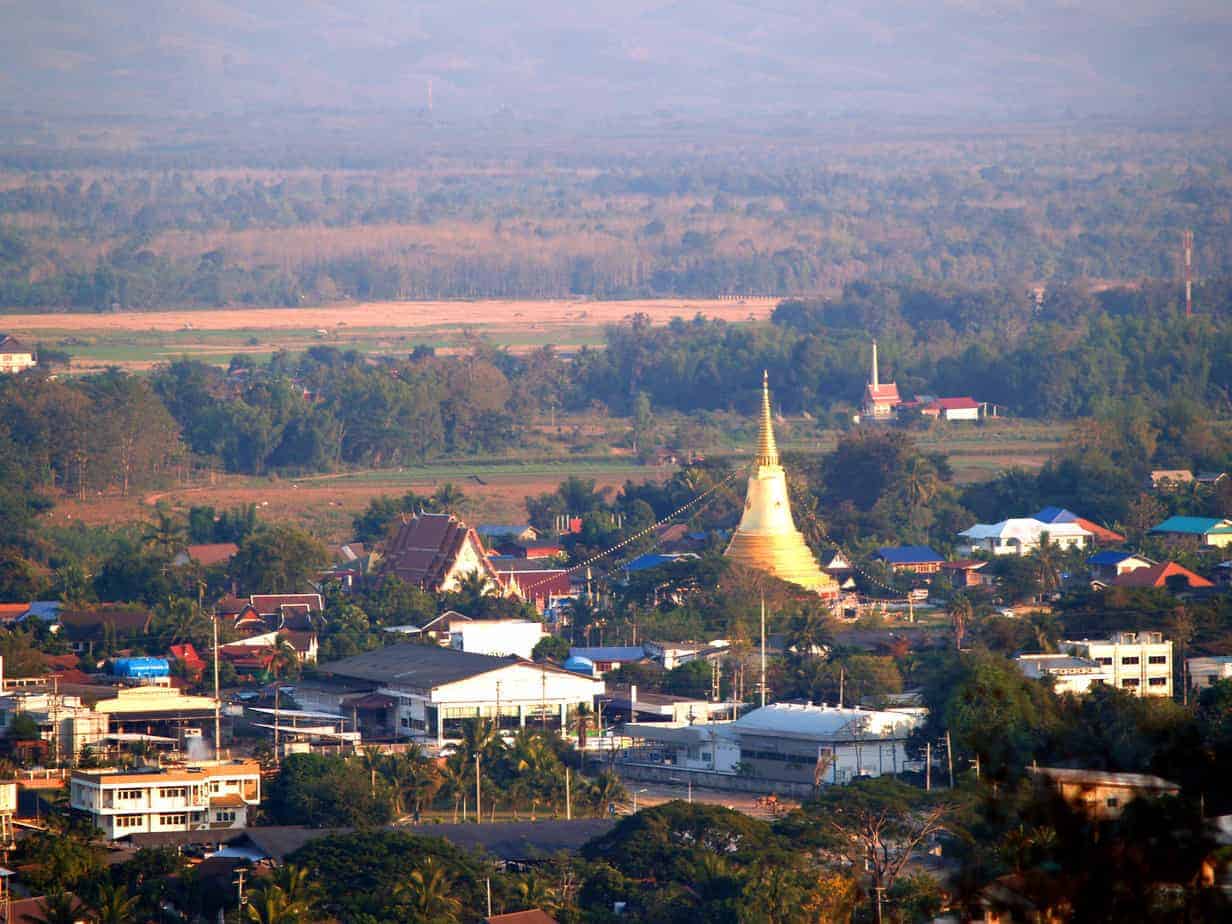The town of Nan is situated 688 km north of Bangkok in northern Thailand. It is the administrative capital and the main town of the province that bears its name. The area is 7.60 sq. km. It is divided into thirty chumchon. The city is surrounded by natural beauty. You can also find a lot of historical attractions in the area. If you visit the town, you will be able to enjoy the local cuisine, which is known as khao nam.
Nan is a province in northern Thailand. It is located along the country’s border with Laos, and its capital is the city of Nan. It is known for its natural beauty and cultural attractions, including temples and other historical sites. The province is home to a number of ethnic minority groups, and its culture and traditions are influenced by its location along the Mekong River.
Nan was fully autonomous for many centuries and was a part of the Lang Xang empire, also conquered by Burma in 1558. Nan only became a part of Thailand fully in 1931 and was a part of Laos for some of the 19th century.
The main things to do in Nan include:
- see the distinctively different local Wats and the remains of the town’s old walls
- go to the Nan National Museum – the palace of the last 2 feudal lords of Nan
- visit the local night market (Kad Nan) for local food and crafts
- see the King of Nan’s teak house built in 1866 – reconstructed 1941
- visit Wat Phumin built in 1596
- rent a motorbike and visit the local National Parks
History of Nan Thailand
Nestled in the picturesque landscapes of northern Thailand, Nan is a hidden gem with a fascinating history that traces back through centuries. From its ancient origins as a kingdom to its role in the Lan Na and Thai dynasties, Nan’s historical journey is a tapestry of cultural influences and regional significance. Let’s embark on a historical voyage through the evolution of Nan, Thailand, with a timeline of significant events.
Prehistoric Settlements:
- Archaeological evidence suggests that the area around Nan has been inhabited since prehistoric times, with evidence of ancient human settlements and artifacts.
Lan Na Kingdom:
- 14th Century: Nan was part of the Lan Na Kingdom, a powerful Tai state that flourished in northern Thailand, with its capital in Chiang Mai.
- Late 14th Century: King Mangrai of Lan Na appointed his son, Chao Sam Phraya, as the ruler of Nan, establishing Nan as a vassal state within the Lan Na Kingdom.
Ayutthaya Kingdom Rule:
- 16th Century: The Ayutthaya Kingdom, based in central Thailand, extended its influence over Nan, bringing the region under its control.
Burma’s Brief Rule:
- 18th Century: During the Burmese-Siamese War, the Burmese briefly occupied Nan, leaving a mark on the region’s history.
Emergence of Nan as a Principality:
- 1796: Nan emerged as a principality under the rule of Chao Ananta Vora Ritthi Det, who was appointed as the first prince of Nan by King Rama I of Siam (Thailand).
Chao Ananta Vora Ritthi Det’s Legacy:
- Chao Ananta Vora Ritthi Det and his successors ruled Nan for over a century, contributing to the region’s prosperity and development.
Thailand’s Modernisation:
- Early 20th Century: Nan, along with other Thai principalities, became an integral part of the modernising Kingdom of Thailand, under the reign of King Rama V (King Chulalongkorn).
World War II and Japanese Occupation:
- 1941: During World War II, Thailand was occupied by the Japanese forces, including Nan. After the war, Thailand regained its independence.
Present Day:
- Today: Nan stands as a serene and culturally rich province of Thailand, known for its historical landmarks, traditional crafts, and lush landscapes.
Cultural Heritage and Attractions:
- Nan is celebrated for its well-preserved temples, including Wat Phumin and Wat Phra That Khao Noi, which offer insights into the region’s religious and architectural heritage.
- The Nan National Museum showcases the province’s history through artifacts and exhibits.
Cultural and Festive Traditions:
- Nan’s cultural diversity is reflected in its various festivals, such as the Candle Festival and the Nan Boat Racing Festival, which bring communities together in celebration.
Eco-Tourism and Nature Exploration:
- The region’s natural beauty attracts eco-tourists, with opportunities for trekking, exploring national parks, and discovering stunning waterfalls.
As travellers explore Nan, they are rewarded with glimpses of a rich past and a vibrant present, harmoniously intertwined in this captivating destination of Thailand. The province’s historical landmarks, cultural traditions, and natural splendor make it a hidden gem waiting to be discovered by those seeking a journey through time in northern Thailand.
Must Do
You can explore the lush forests and mountains of the city of Nan. You can see the beautiful greenery and tropical forests of the surrounding area. Wat Phumin is the city’s most well-known wat. It is located near the Nan National Museum. Wat Phumin is the site of the Pu Man Ya Man painting, which is known as the world whispering image. For an art experience, you can also check out the Nan Riverside Art Gallery, a large private gallery on the banks of the River Nan. It is the cultural hub of the province. It was founded by Winai Prabripoo in 2003 and has been the home of over 80 and 100 artworks.
The town is not known for its nightlife, but the abundance of woods makes it a perfect place for those who enjoy nature. If you are an avid hiker, you can visit the nearby mountains to climb Phu Khae, which is the province’s tallest mountain. Once you’ve conquered Phu Khae, you can spend a relaxing evening by the river. You can also visit the Weerachon pub and try out some of the local cuisine. Besides the pubs, there are also a couple of nightclubs in the area.
- See the sunrise from a misty mountain top.
- Watch dragon boats race their way down the Nan river
- Brave the currents and white water raft the Wa river.
- Shop at the morning market and see the strange looking vegetables
- Chill out at the riverside art gallery.
- Bike around the rice fields and foothills that surround the town.
- Learn about the towns history at the local museum
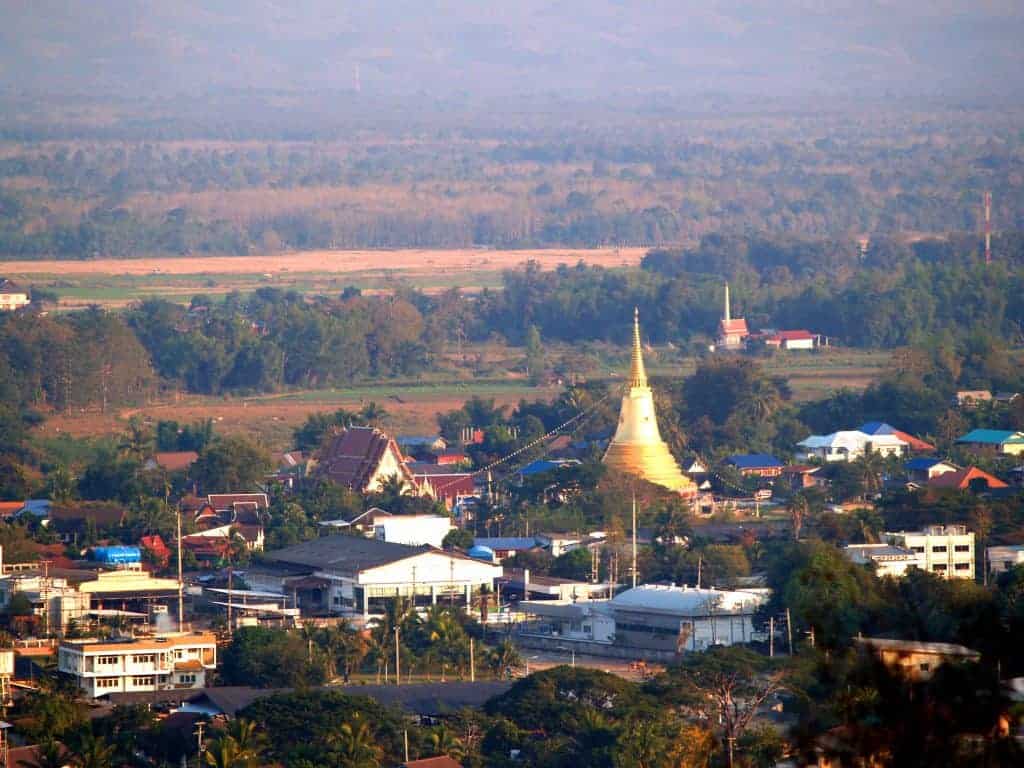
What do you like best about Nan
The old wooden buildings, the stunning murals in Wat Pumin temple, the colourful ‘dragon’ boats on the river, and, most of all the peaceful atmosphere in both the town and the beautiful countryside that surrounds it.
It’s a quiet place but there’s a lot to see and do, both in and around the town.
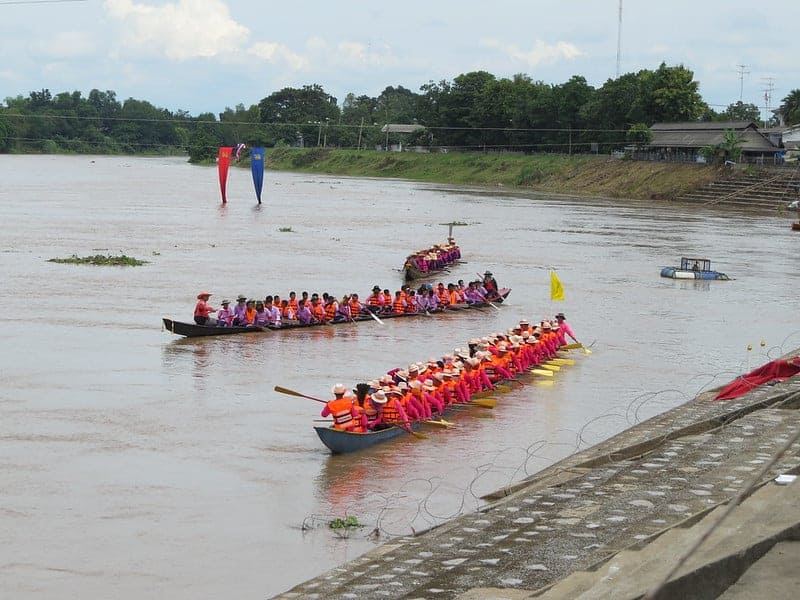
Best Restaurants in Nan
Here are a few restaurants to try in Nan City
- Crossroads Nan – Visitors can eat tasty burgers, steaks and beef at this restaurant. You will be offered delicious beer. It’s always a pleasure to rest and have a meal here because of the prompt service.
- Ban J Vegetarian Restaurant – People can eat good soup at this restaurant. The competent staff works hard, stays positive and makes this place wonderful. The pretty atmosphere makes a positive impression on guests.
- Poom 3 Nan can be recommended for perfectly cooked chicken curry, roti and massaman curry.
- Rai Tiam Than Noodle
- Huen Chao Nang
Desserts
For dessert lovers, the most amazing ice cream in town comes from Bar Min Ice cream restaurant. Sweet red sticky rice, covered with traditional thai style coconut ice cream, and topped with hot chocolate sauce is just one of their specialities.
Thai teenagers love to visit milkshake bars. They’re usually stylishly designed and sell cheap shakes and snacks. There are a couple in town but the nicest by miles is ‘The Milk Club.’ Order a milkshake and toast topped with anything from chocolate and coconut, to chinese style pork. Once you’ve finished eating take a look at the coke memorobilia, the photos and paintings on the wall and the upstairs gallery.
Bakeries and Coffee Shops
The Best’ bakery sells the best western style cakes around. Their new York cheesecake and banoffee pie can’t be beat, it really lives up to its name as the best bakery in town.
In the last few years theres been an explosion of new coffee shops in town. Phu Payak and Phu Far (both selling locally grown Nan coffee) are the best. Muan Jai comes a close second.
Local Markets in Nan
If you’re on a budget or just out to try something different there are food stalls in the morning market. They sell everything and anything from pre-packed cartons of curry and rice to fresh fruit. Try ‘joke’ – a thai style congee and ‘cafee boran’ hot Laos style coffee for breakfast.
Later in the day there’s ‘to rung’ night market, a street where almost every stall sells food. Deep fried insects, curries, pat thai noodles, BBQ chicken, rice soups, japanese sushi and fresh fruit are all on sale here. Several stalls will cook food to order. Just tell the cook what you would like, or point at a dish you like the look of and, a couple of minutes later a nice steaming hot plate of it will appear in front of you.
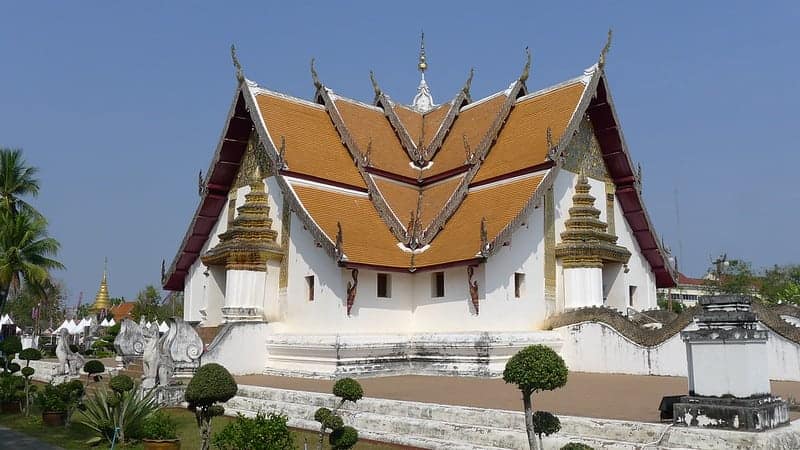
Best Places to Stay in Nan
Nan is a small town of about 21,000 people. Most of the places to stay in Nan are smaller guesthouses and small hotels. I have a small list of places that ypu can click on the links and that will take you to TripAdvisor for a better description and customer reviews.
Nan Noble House Garden Resort is a resort with charming thatched cottages set in a seven acre landscaped garden. Situated close to Nan city. There is a large swimming pool, separate pool area for kids, one km jogging track and hundreds of trees.
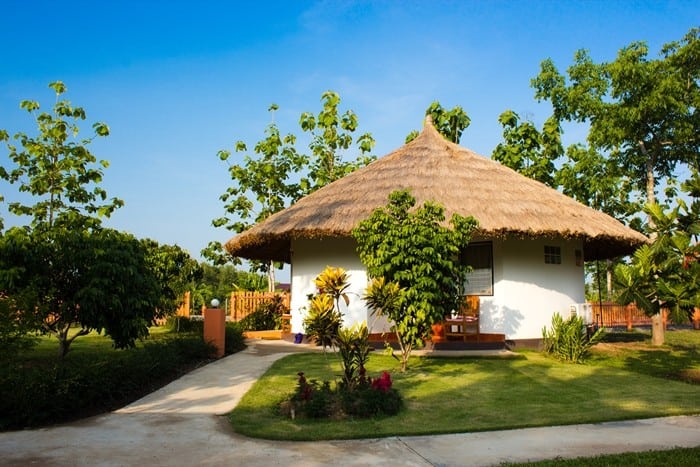
Nan Guest House is a long time favorite in Nan. It has clean rooms, good value and a friendly service. It’s located close to the bus station and the center of Town, in a quiet residential area.
Nan Seasons Boutique Resort is a comfortable 4 star Boutique Resort with a Pool and has a spectacular view over the Countryside, Temples and Mountains. The Superior Bungalows and Villas are all from local Teak wood and are decorated with comfortable and modern contemporary Lanna-Thai design. They all have Air-conditioning, Minibars, Tea and Coffee, HD TV, Mineral rain showers and spacious Balconies.
Sasidara Resort Nan is nestled in the verdant valley of northern nature and culture, Nan is a fascinating destination offering you a great experience of Thailand northern outstanding way of life.
Best Music/Festivals
Nan’s not known for its music scene. Traditional northern Thai music and northern dances can usally be seen and heard at the monthly street market. Some pubs and restraunts also have live music, the singers and bands usually play covers version of Thai rock songs.
From July onwards, the town starts to go boat crazy. Each evening, if you go down to the river you can hear teams of rowers counting from 1-8 as they practise their strokes. By the end of September the area by the river is turned into a giant market and the 1st of the province’s famous ‘Boat Racing Festival’s’ begins. Bus loads of locals from the surrounding villages arrive, along with amplifiers, bands, cheerleaders and iceboxes full of beer. After the boats have been blessed and put onto the water, the races begin. The villages take their boat very seriously. The river becomes a sea of colour and raucous cheering accompanies every race.
Nan also celebrates most of the other major Thai festivals and events. Songkran, Thai New Year, a 7 day water war is definitely worth seeing, as is Loi Kratong (the first full moon in November) when, just after sunset people float tiny candle-lit rafts on the river.
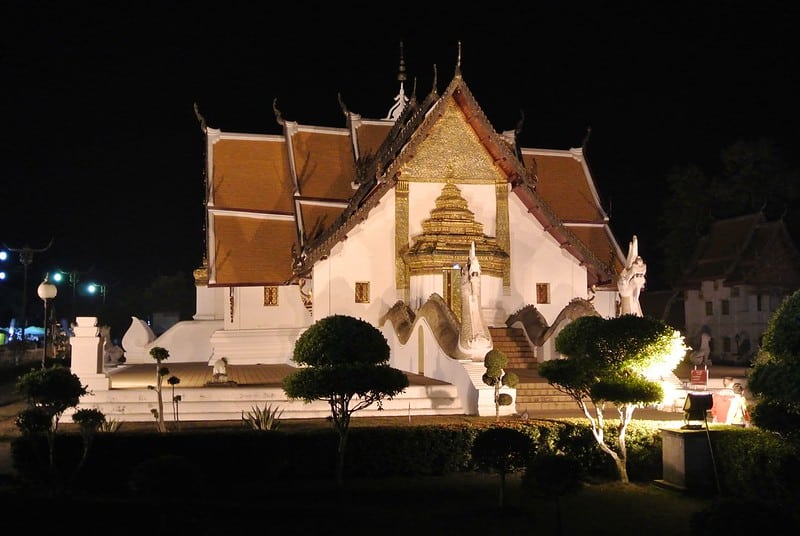
Art Galleries in Nan
The Nan Riverside Art Gallery is a large private art gallery. It is situated on the bank of the Nan River about 20km from Nan City. It functions as a centre of Nan province’s art and culture. The gallery was founded by Winai Prabripoo, a famous Thai artist and native of Nan, who loves art. A large hall on the first floor hosts large exhibition. It can support more than 80-100 artworks.
The Sudrit Arts Gallery is in Nan City and is primarily a small hotel but look as though they sell art on the side.
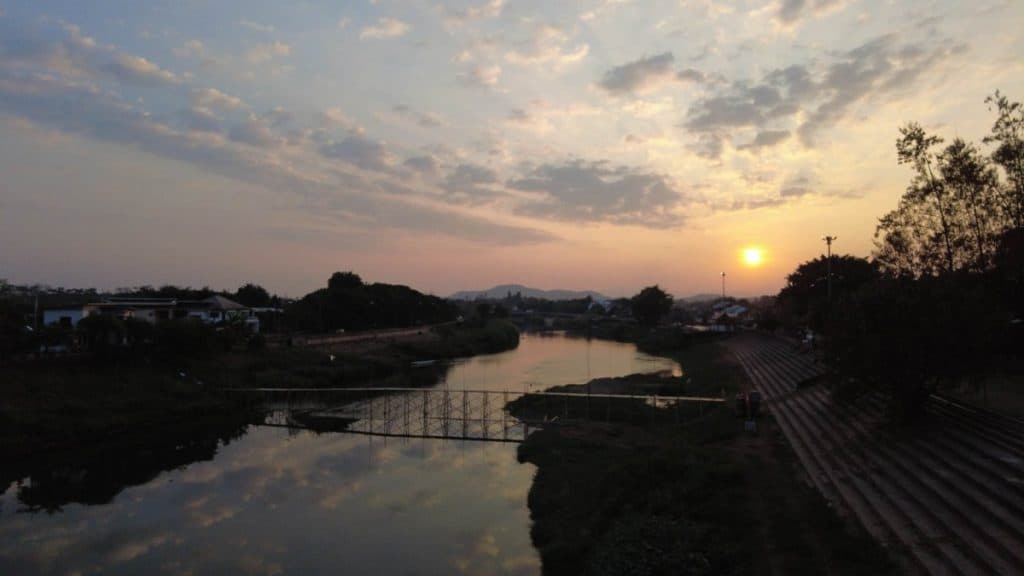
Best Nightlife in Nan
Nan’s not exactly the nightlife capital of Thailand. Dining by the river (recommended restaurants are the 2 opposite Phu Far coffee shop, gourmet or ‘the glass house’) is a nice way to spend a warm summer evening.
For live music (classic Thai rocks songs and a couple English cover versions) head to Weerachon pub, or one of the few nightclubs in town, the fifth or channel X.
2 or 3 days a month there’s a ‘walking’ street, an outdoor market selling clothes, souveniers and food. There’s usually a cultural show, where people dress in traditional costume and demonstate traditional dancing too.
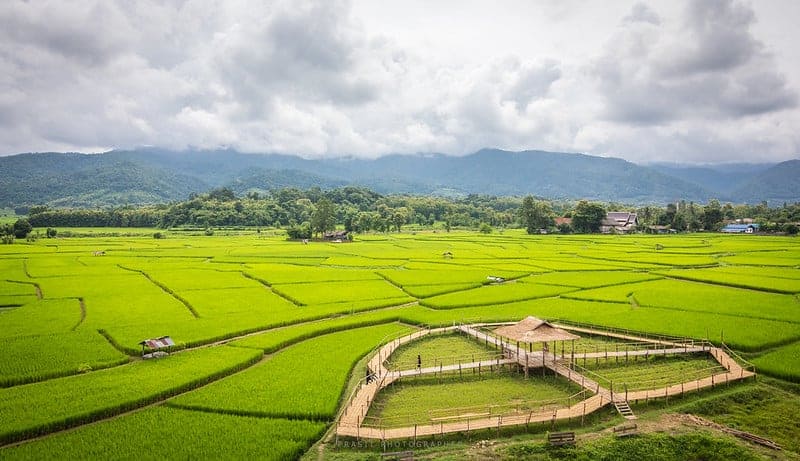
Best Day Trip out of Nan
The surrounding mountains – any of them. Doi Sameur Dao or Doi Phu Kha for stunning views, Doi Phu Wae for a strenous hike or Doi Tiew for the chance to see how the Hmong people live.
In the rainy season, several tour companies organise 2-3 day white water rafting trips on the Wa river.
Something not many tourists would know about Nan
Take a trip to Haad Pa Kon village, order food, hire a rafthouse and spend a few hours drifting down the Nan river, swimming, fishing and staring at the scenery.
10 Interesting facts about Nan Thailand
- Ancient Roots: Nan has a long history dating back to ancient times, with archaeological evidence suggesting human settlement in the region since prehistoric periods.
- Nan’s City Wall: The city of Nan was historically protected by a massive city wall, remnants of which can still be seen today.
- Lan Na Influences: Nan was once part of the Lan Na Kingdom, a powerful Tai state that flourished in northern Thailand, and has retained many influences from this historical period.
- Wat Phumin Murals: Wat Phumin, a renowned temple in Nan, is famous for its intricate murals depicting local life and folklore scenes, making it an artistic treasure.
- Unique Tai Lue Culture: Nan is home to the Tai Lue people, who have a distinct culture and traditions, including their language and vibrant festivals.
- Salt Pans: The Bo Kluea district in Nan is known for its traditional salt pans, where locals extract salt from natural saltwater springs, offering a unique sight for visitors.
- Nan National Museum: The Nan National Museum houses an extensive collection of artifacts, antiques, and historical exhibits that showcase the region’s rich cultural heritage.
- Nan Riverside Art Gallery: This unique gallery showcases contemporary and traditional artwork of local artists, providing insight into Nan’s thriving art scene.
- Phu Phayak Forest Park: Nature enthusiasts can explore Phu Phayak Forest Park, a tranquil area with hiking trails, waterfalls, and diverse wildlife.
- Thung Chang Buddha Statue: The largest seated Buddha statue in Southeast Asia, standing at 30 metres tall, is located in Thung Chang District, Nan.

